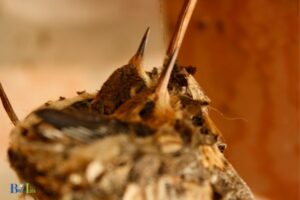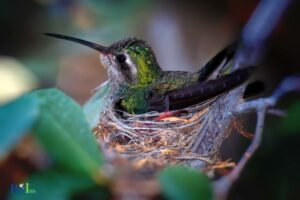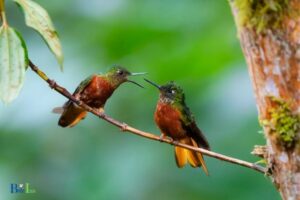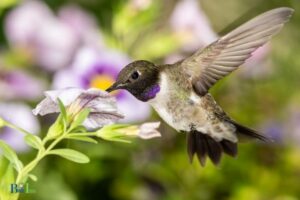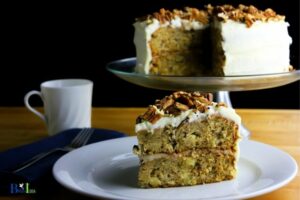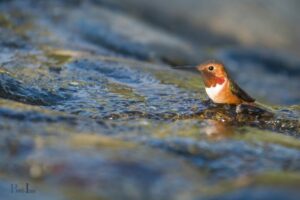When Do Hummingbirds Nest in the Pacific Northwest: Feb-Jun
Hummingbirds typically nest in the Pacific Northwest between late February and early June.
In the Pacific Northwest, hummingbird nesting season generally begins in late winter and extends into early summer.
During this time, the region’s most common species, the Anna’s Hummingbird and Rufous Hummingbird, establish their nests to lay eggs and rear their young.
The exact timing varies depending on the species and local conditions, but generally aligns with the availability of food sources such as nectar-producing plants and insects.
These nests are intricately constructed using various materials like plant fibers, moss, and spiderwebs, creating a secure and insulated environment for their eggs and young.
It is essential for people in the Pacific Northwest to be aware of this crucial time for hummingbirds and take necessary precautions to protect their nesting sites, such as avoiding disturbance and providing proper food sources like nectar feeders.
12 Months Timeline of Hummingbirds Nest in the Pacific Northwest
| Month | Nesting Activity |
| January | Rare |
| February | Beginning |
| March | Common |
| April | Peak |
| May | Peak |
| June | Common |
| July | Late nesting/raising young |
| August | Rare |
| September | None |
| October | None |
| November | None |
| December | None |
Key Takeaway
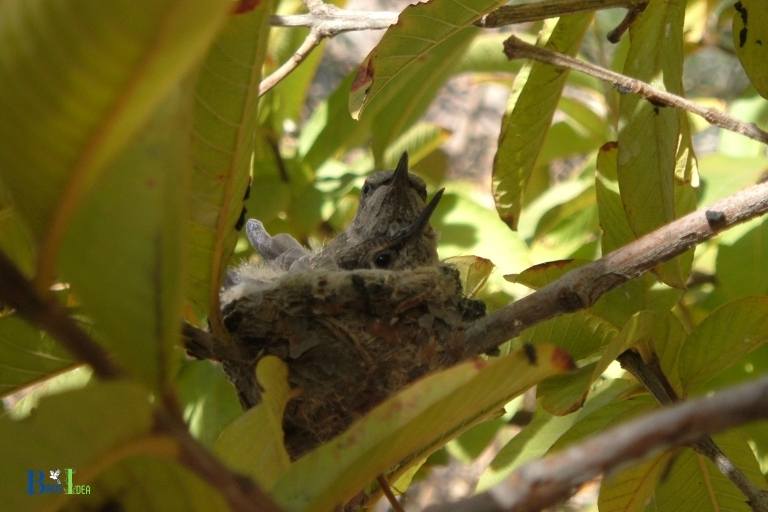
Five Facts About: Hummingbirds Nesting in the Pacific Northwest
Different Hummingbird Species In The Pacific Northwest And Their Nesting Habits
Hummingbirds are a charming sight to behold for bird watchers and nature enthusiasts alike. With their tiny size and ability to hover in mid-air, it’s no wonder they are a favourite amongst many bird lovers.
If you reside in the pacific northwest, you may be wondering when hummingbirds begin to nest in this region.
We will be discussing the different hummingbird species found in the pacific northwest and their nesting habits.
Rufous Hummingbird
Rufous hummingbirds are among the most common species found in the pacific northwest and are known for their stunning orange-red plumage.
Here are some key points on the nesting habits of these hummingbirds:
- Rufous hummingbirds typically begin to nest in late march or early april, with the female choosing a site for her nest, usually near a plentiful food source.
- Females usually build their nests in deciduous trees or shrubs, and the nest is built primarily out of plant fibres, spider silk and lichen, expanding as the chicks grow.
- Females lay two eggs on average, and the eggs hatch approximately 15-17 days after they are laid.
- Rufous hummingbirds are known for being aggressive nest defenders, with both male and female birds working together to protect the nest from predators.
Anna’S Hummingbird
Named after anna masséna, duchess of rivoli, anna’s hummingbirds are another common species seen in the pacific northwest. They are known for their striking iridescent feathers and unusual courtship display.
Here are some key points on the nesting habits of these hummingbirds:
- Anna’s hummingbirds begin nesting earlier than most hummingbird species, with some birds beginning as early as december in some areas of the pacific northwest.
- Females usually build their nests in a sheltered area, such as dense foliage, small trees, or shrubs, and the nest is built primarily with plant down, with bits of leaves and lichen for camouflage.
- Females lay two eggs on average, and the eggs take roughly 16-18 days to hatch.
- Anna’s hummingbirds are known for their boldness and will defend their nests fiercely.
If you live in the pacific northwest and want to watch hummingbirds, the best time to look out for these little birds is in the spring and early summer.
Whether you are watching a rufous or anna’s hummingbird, with their distinctive nesting habits and striking beauty, it’s a sight not to be missed.
Environmental Factors Affecting Nesting Season
When Do Hummingbirds Nest In The Pacific Northwest
Hummingbirds are the true marvels of avian world, with their iridescent feathers and amazing ability to fly in all directions. If you live in the pacific northwest and have been wondering about the nesting season of hummingbirds, this blog post is for you.
The pacific northwest is a vast region with different climatic zones, meaning that the nesting season of hummingbirds varies depending on the location.
Climate And Temperature
The temperature and climate have a profound impact on the nesting season of hummingbirds. If the temperature is too low, hummingbirds will not be able to survive.
Here are some key points to consider:
- The ideal temperature for hummingbirds to start nesting is between 50 and 55 degrees fahrenheit.
- The temperature should remain above freezing level constantly.
- Frost can damage nestlings and eggs, so it is better to avoid starting nesting before the spring.
Precipitation And Rainfall
Rainfall is a necessary environmental factor for hummingbirds to thrive, but excessive precipitation can lead to flooding and destruction of nests.
Here are some key points to consider:
- Hummingbirds need rainfall to adjust the moisture and humidity levels in their nests and for the nectar and pollen sources to grow.
- Heavy precipitation can wash away nests and damage eggs and nestlings.
- The best time for hummingbirds to start nesting is after the rainy season when there is enough precipitation, but the risk of floods has decreased.
Pollen And Nectar Availability
Hummingbirds have a high metabolic rate, and they need to feed constantly to maintain it. Without a stable source of nectar and pollen, they won’t have the energy to start nesting.
Here are some key points to consider:
- Hummingbirds need a consistent and stable source of nectar and pollen to survive.
- Climate and precipitation affect the availability of nectar and pollen.
- The nesting season of hummingbirds is correlated with the availability of nectar and pollen, so the best time for them to start nesting is when these sources are abundant.
The best time for hummingbirds to start nesting in the pacific northwest is after the rainy season when the temperature is consistently warm enough, there is a stable source of nectar and pollen, and the risk of floods has decreased.
Understanding the environmental factors affecting the nesting season of hummingbirds can help you attract them to your garden and provide a suitable environment for them to thrive.
Hummingbird Nesting Behaviors
Hummingbirds are among the most fascinating species in the pacific northwest for their unique behaviors, especially when it comes to nesting.
The sight of these tiny flying creatures hovering over their nests is awe-inspiring. But when do hummingbirds nest in the pacific northwest exactly?
In this section, we explore hummingbird nesting behaviors and answer this question with precision.
Mating Season And Courtship Rituals
Mating season for hummingbirds in the pacific northwest typically starts in march or april, and it can last until early fall. The male hummingbirds are responsible for attracting and courting females.
They achieve this by performing mesmerizing aerial displays and singing songs that are unique to their species.
When a female hummingbird is impressed by a male’s courtship display, they will mate, and the female will begin nesting.
Nest Building
Hummingbirds are fastidious nest builders and construct their nests using spider silk and plant material. They build their nests high in trees and often on the end of branches, making them challenging to spot.
The nests take about 5 to 7 days to build, and they are incredibly small, measuring around 2 inches in diameter and 1 inch deep.
The female hummingbird lays only one to three eggs at a time, and she incubates them for approximately 16 to 18 days.
Incubation And Fledgling
After hatching, the baby hummingbirds are entirely dependent on their mother for food and protection. They stay in the nest and grow rapidly for about three weeks before they are ready to fledge.
The mother hummingbird feeds them a diet of insects and nectar regularly.
The fledglings leave the nest after an additional 18 to 30 days and begin their independent life.
Hummingbirds usually nest in the pacific northwest between april and august. They are fascinating creatures with incredible nesting behaviors, from building their nests to incubation and fledgling.
If you’re lucky enough to spot a hummingbird nest, take a moment to appreciate the remarkable resilience and adaptability of these tiny birds.
FAQ On When Do Hummingbirds Nest In The Pacific Northwest
What Is The Nesting Season Of Hummingbirds In The Pacific Northwest?
Where Do Hummingbirds Build Their Nests In The Pacific Northwest?
How Many Eggs Do Hummingbirds Lay During Nesting Season In The Pacific Northwest?
Can I Attract Hummingbirds To Nest In My Yard In The Pacific Northwest?
How Long Does It Take For Hummingbird Eggs To Hatch In The Pacific Northwest?
Conclusion
Hummingbirds are a common sight in the pacific northwest during the spring and summer months. With their vibrant colors and impressive precision, they are a source of fascination for many bird watchers and nature enthusiasts.
Understanding their nesting patterns and behaviors can help us to protect and preserve these tiny creatures.
Keep an eye out for the tell-tale signs of a hummingbird nest, such as a small, cup-shaped structure made from moss, lichen, and spiderwebs. If you’re lucky enough to spot a nest, be sure to keep a safe distance and avoid disturbing the birds.
With a little patience and curiosity, you can gain a deeper appreciation for these amazing creatures and the important role they play in our ecosystem. Thanks for reading, and happy bird watching!

